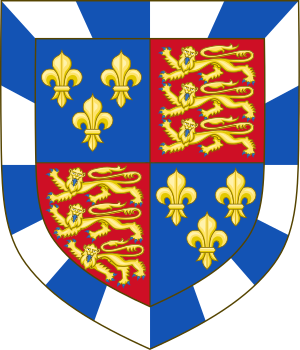Edmund Beaufort (died 1471) facts for kids
Quick facts for kids
Edmund Beaufort
|
|
|---|---|
| Duke of Somerset | |
|
Execution of the Duke of Somerset at Tewkesbury in 1471
|
|
| Born | c. 1438 |
| Died | 6 May 1471 (aged 32–33) Tewkesbury, Gloucestershire, England |
| Buried | Tewkesbury Abbey |
| Noble family | Beaufort |
| Father | Edmund Beaufort, 2nd Duke of Somerset |
| Mother | Eleanor Beauchamp, Duchess of Somerset |
Edmund Beaufort (born around 1438, died 1471) was an important English noble. He was a military leader during the Wars of the Roses. He fought for King Henry VI and the House of Lancaster. He was known as the 4th Duke of Somerset.
Contents
Early Life and Family

Edmund Beaufort was born about 1438. His father was Edmund Beaufort, 2nd Duke of Somerset. His mother was Eleanor de Beauchamp. Eleanor was the daughter of Richard Beauchamp, 13th Earl of Warwick. Edmund had an older brother named Henry Beaufort, 3rd Duke of Somerset. Henry was born in 1436 and died in 1464.
Life in France
After the Lancastrians lost a major battle in 1461, Edmund went to live in France. He was there with his younger brother, John Beaufort, Marquess of Dorset. In 1464, his older brother Henry was executed after the Battle of Hexham. Even though his brother's titles were taken away, some Lancastrians still called Edmund the 4th Duke of Somerset. This happened in February 1471. However, King Edward IV's side did not recognize this title. They called him "Edmund Beaufort, calling himself duke of Somerset."
Return to England and the Wars of the Roses
In October 1470, Edmund Beaufort came back to England from France. This was when King Edward IV had been removed from the throne. Warwick had switched sides and joined Queen Margaret. This led to the return of King Henry VI to power. King Henry VI sometimes struggled with his mental health. Queen Margaret often helped him with his royal duties.
Challenges and Battles
Edmund Beaufort was not very happy about the peace between the different groups. He did not try hard to help. His failure to protect London from Edward IV was a big moment. This led to the Battle of Barnet on April 14, 1471. Warwick was killed in this battle. Some old records say Edmund was at Barnet, but this is not correct.
After Barnet, Edmund tried to escape west towards Wales. He wanted to get help from Jasper Tudor. But the Yorkist army stopped him. This led to the Battle of Tewkesbury on May 4, 1471.
The Battle of Tewkesbury
At Tewkesbury, Edmund led the front part of the Lancastrian army. His position was very strong. But when the battle started, he moved his troops down from the high ground. He attacked King Edward IV's right side. Both the King and Richard, Duke of Gloucester, attacked him back. Edmund's troops were quickly defeated. His actions during the battle helped the Yorkists win.
Death and Legacy
After the defeat at Tewkesbury, Edmund and other Lancastrian leaders hid in Tewkesbury Abbey. But they were forced out of the church two days later. They were put on trial and executed right away. This happened at the Cross in the center of Tewkesbury on Monday, May 6, 1471.
Burial and Family Line
Edmund was buried on the south side of Tewkesbury Abbey. His younger brother John had been killed during the battle. Since both brothers died without getting married, the Beaufort family line ended. All their noble titles were lost.
Soon after, King Henry VI also died. This meant that Edmund's cousin, Lady Margaret Beaufort, and her son, Henry Tudor, became the main representatives of the House of Lancaster. Henry Tudor later became King Henry VII.

